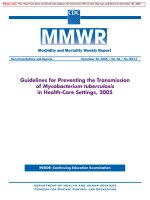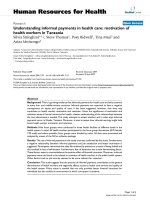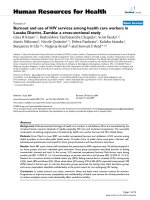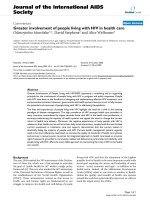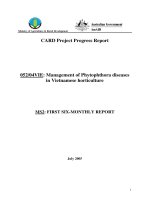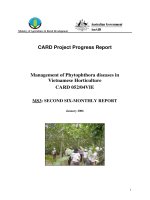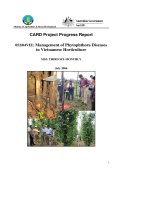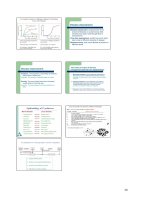TRUST MANAGEMENT OF SOCIAL NETWORK IN HEALTH CARE
Bạn đang xem bản rút gọn của tài liệu. Xem và tải ngay bản đầy đủ của tài liệu tại đây (741.5 KB, 66 trang )
Graduate School ETD Form 9
(Revised 12/07)
PURDUE UNIVERSITY
GRADUATE SCHOOL
Thesis/Dissertation Acceptance
This is to certify that the thesis/dissertation prepared
By
Entitled
For the degree of
Is approved by the final examining committee:
Chair
To the best of my knowledge and as understood by the student in the Research Integrity and
Copyright Disclaimer (Graduate School Form 20), this thesis/dissertation adheres to the provisions of
Purdue University’s “Policy on Integrity in Research” and the use of copyrighted material.
Approved by Major Professor(s): ____________________________________
____________________________________
Approved by:
Head of the Graduate Program Date
Pawat Chomphoosang
Trust Management of Social Network in Heath Care
Master of Science
Arjan Durresi
Rajeev R. Raje
Yao Liang
Arjan Durresi
Shiaofen Fang
11/06/2012
TRUST MANAGEMENT OF SOCIAL NETWORK IN HEALTH CARE
A Thesis
Submitted to the Faculty
of
Purdue University
by
Pawat Chomphoosang
In Partial Fulfillment of the
Requirements for the Degree
of
Master of Science
May 2013
Purdue University
Indianapolis, Indiana
ii
ACKNOWLEDGEMENTS
The work described in this thesis has been accomplished due to the
assistance and support of many people to whom I would like to express my
utmost gratitude. I would like to thank my research advisor, Dr. Arjan Durresi, for
his encouragement and support as well as his invaluable advice during the thesis.
Also, thanks to Dr. Rajeev R. Raje, Dr. Yao Liang, and Dr. Mohammad Al Hasan
who have reviewed this thesis and have given me many good advises to improve
the quality. Without the assistance of them, I could not accomplish the work. I am
indebted to staff members of Department of Computer and Information Science
for providing suggestions, assistance, and especially friendship which greatly
supported me in my work. I would like to express my appreciation to my friends,
especially Ping Zhang, Danar Widyantoro and Yefeng Ruan who have helped,
either directly or indirectly, to stimulate my thought processes in this work. I
would like to thank my family for their continual encouragement and patient
during the time of study.
iii
TABLE OF CONTENTS
Page
LIST OF FIGURES v
ABSTRACT vii
CHAPTER 1. INTRODUCTION 1
1.1 Introduction 1
1.2 Trust Framework 2
1.3 Organization of this thesis 5
CHAPTER 2. SOURCES OF INFORMATION 6
2.1 Health Web Portals 6
2.2 Collaborative Information Sharing 7
2.3 Social Network Sites 7
2.4 Multimedia 8
CHAPTER 3. POSSIBLE ISSUES 10
3.1 Network Formation 10
3.2 Dissemination 10
3.3 Standard Malicious Attacks 11
CHAPTER 4. THEORETICAL BACKGROUNDS 13
4.1 Trust Metric Inspired by Measurement and Psychology 13
iv
Page
4.1.1 Psychology Implication 13
4.1.2 Trust Metrics (Impression and Confidence) 14
4.1.3 Value and Range of Trust Metrics 15
4.2 Trust Arithmetic Based on Error Propagation Theory 16
4.2.1 Trust Transitivity 17
4.2.2 Trust Aggregation 19
CHAPTER 5. EXPERIMENTS AND ANALYSIS 24
5.1 Data Crawling and Creating Social Networking 24
5.2 Verification of our Framework 25
5.3 Attack Modeling and Consequential Effects 29
5.4 Pharma Marketing Model 34
5.5 Contradiction of Knowledge Opinion Leader (KOL) 37
CHAPTER 6. COMPARISION TO PREVIOUS WORKS 44
6.1 Robustness to Attackers 44
6.2 Identification of Influencers 46
CHAPTER 7. RELATED WORKS 48
7.1 The Trustworthiness of Source and Claim 48
7.2 Finding and Monitoring Influential Users 51
CHAPTER 8. CONCLUSION AND FUTURE WORK 52
REFERENCES 53
APPENDIX 56
v
LIST OF FIGURES
Figure Page
Figure 1 A Chain of Trust 17
Figure 2 Trust Aggregation 19
Figure 3 Conservative Way of Combination 22
Figure 4 A pattern Retrieved for Verification 25
Figure 5 Difference between m and c 27
Figure 6 Distribution of Confidence without Aggregation 27
Figure 7 Distribution of Confidence with Aggregation 28
Figure 8 Illustration of How Node A Receives Message from Z 30
Figure 9 Total Impact of Attackers on Epinions 32
Figure 10 Total Impact of Power User Attacker by Applying Thresholds on
Epinions 33
Figure 11 Total Impact of Less Known User Attackers by Applying
Thresholds on Epinions 33
Figure 12 Total Impacts of Fake User Attackers 34
Figure 13 Difference between Two Selection Methods 35
Figure 14 Simple AD Effect 37
Figure 15 Intelligent AD Effect 37
vi
Figure Page
Figure 16 Combined Impact for 10 KOLs 40
Figure 17 Number of Nodes Receiving Negative Opinions 40
Figure 18 Impact of Contradictory Opinions 42
Figure 19 Number of Positive Nodes toward Conflict Opinions 42
Figure 20 Impact of Contradictory Opinions with Fake Nodes 43
Figure 21 Number of Positive Nodes toward Conflict Opinions
with Fake Nodes 43
Figure 22 Comparison of Robustness with a Previous Work 45
Figure 23 Zooming Comparison of Robustness 45
Figure 24 Comparison of Selection Methods 46
Figure 25 Comparison of Selection Methods with Fake Nodes 47
Figure 26 The example of a review page and product we collected 56
Figure 27 The example of a rating page and product we collected 56
vii
ABSTRACT
Chomphoosang, Pawat. M.S., Purdue University, May 2013. Trust Management
of Social Network in Health Care. Major Professor: Arjarn Durresi.
The reliability of information in health social network sites (HSNS) is an
imperative concern since false information can cause tremendous damage to
health consumers. In this thesis, we introduce a trust framework which captures
both human trust level and its uncertainty, and also present advantages of using
the trust framework to intensify the dependability of HSNS, namely filtering
information, increasing the efficiency of pharmacy marketing, and modeling how
to monitor reliability of health information. Several experiments which were
conducted on real health social networks validate the applicability of the trust
framework in the real scenarios.
1
CHAPTER 1. INTRODUCTION
1.1 Introduction
There are more than twenty thousand health-related sites available on the
Internet and over 62% of Americans as estimated by [1] have been influenced by
the health information provided on news websites and the Internet, whereas 13%
received the information from their physicians. Additionally, one study [2] shows
that 87% of Internet users who look for health information believe that the
information they read online about health is reliable, while another study [3]
revealed that less than half of the medical information available online has been
reviewed by medical experts and only 20% of Internet users verify the
information by visiting authoritative websites such as CDC and FDA. As Health
Social Networking Sites (HSNS) have emerged as a platform for disseminating
and sharing of health-related information, people tend to rely on it before making
healthcare decisions, such as choosing health care providers, determining a
course of treatment and managing their health risks The work of [4] points out
that the complex nature of HSNS has some unique challenges for both health
consumers and service providers.
First, the health information is considered as highly sensitive information.
Without deliberate consideration, the consumers may receive misleading
2
information which may cause them severe damage. There are examples of
misleading information written by [5].
Second, as health service providers, their reputation can be attacked by
malicious users or honest users due to unethical competition or poor service. The
report [6] describes that many physicians got negative reviews and ratings from
review websites, and it’s unclear for viewers whether or not reviews and ratings
are real. One possible solution is for the providers to attempt to eliminate the
negative reviews. They may pay the owners of those sites to eliminate bad
reviews or instead find someone to write good reviews to hide the negative
reviews. As a result, both health consumers and service providers should be
aware of several possible threats, including spreading disinformation, distributed
denial of service, distorted advertisement and many others in the future. As in all
systems dealing with information, HSNS will be successfully used if and only if it
could provide reliability of information with a certain level of information security.
Hence, the concept of trust will come into the picture.
1.2 Trust Framework
The trust framework [7] was developed based on the similarities between
human trust operations and physical measurements. It consists of trust metrics
and management methods to aggregate trust, which are based on measurement
theory and guided by psychology and intuitive thinking. In general, the framework
introduces two metrics, named m and c, both of which represent an
interrelationship between nodes. m presents how one node, say Alice, evaluates
3
the trustworthiness of another node, say Bob. Meanwhile, c represents how Alice
is certain about the m opinion. We elaborate the theories and the framework
further in Chapter 4. In this thesis, our purpose is to apply the trust framework to
enable both individuals and system administrators to fulfill utilization of HSNS
through the following functionalities.
First, individuals and administrators can use the framework for information
filtering. If individuals use m and c metrics, the metrics can be a tool to assist the
users whether information sources are reliable or not. Suppose, the consumer is
looking for opinions about drug A, s/he is querying on his or her HSNS. Suppose
there are many other users sharing both positive and negative opinions. S/he can
use the trust transitive and aggregation equations to compute m and c, which are
the indicators to discern the reliable information from the unreliable. The sources
with low c are eliminated; meanwhile the sources with high c are being
considered. In any case, if m opinions among sources of high c are similar, the
consumer will gain more confidence(c) in the opinion. However, if m opinions
among the sources are dissimilar, the consumer will lower c. This probably leads
the consumer to acquire more information or the closed knowledge opinion
leader (KOL), such as physicians or health experts, to regain c.
Second, administrators can also use the framework to improve optimized
marketing tools. The existing tools aim to find a group of users who influence the
greatest population in the network. One approach is to find a group of users who
receive the most number of reviews and consider them as high influencers.
Nonetheless, a number of reviews (only direct trust pointing to a user) is easy to
4
generate. This technique is vulnerable to attackers. With the framework, we use
both trust transitive and aggregation models in computing trust relations among
users so-called Trust Power. It is a good indicator for improving the health
marketing tools. A user with a higher score of Trust Power implies the higher
power of influence to other nodes. We also note that a user who has a lot of
direct trust relation does not necessarily have high Trust Power. After considering
Trust Power, it is hard for malicious nodes to attack the system. Administrators
can also use the framework to analyze the reliability of each information source.
Sources that have high Trust Power are considered as reliable sources, while
sources with low Trust Power are eliminated.
Third, administrators can also exploit the framework assist in monitoring
reliability of a public opinion. Suppose KOL expresses an opinion about an object.
The opinion probably makes an influence on his or her followers. As we
mentioned KOL earlier, if many KOLs express opinions which are similar about
the object, many followers who trust those KOLs will agree upon the consensus,
and therefore the combined Trust Power of the object will be high. In other words,
the reliable level of the particular object becomes high. Meanwhile, in case many
KOLs express dissimilar opinions about the object, the confidence for their
followers will be increasing, and consequently the combined Trust Power will be
compromised. This indicates the low level of reliability for a particular object.
Because of this, it is best for administrators to integrate the framework for
monitoring the reliability of health products.
5
Fourth, we also compare the performance of our framework with another
work [28] in two aspects: Robustness to attackers and identification of influencers.
Based on the result, our framework outperforms the previous work.
1.3 Organization of this thesis
This thesis is organized as follows; we review possible sources where
patients seek for information in Chapter 2. In Chapter 3, we explain possible
issues in HSNS. In Chapter 4, we introduce a theoretical background of trust
framework. Furthermore, we present the experiments and analysis that
demonstrate that our methodology is applicable in the real world in Chapter 5.
We compare the performance of our framework with the other framework in
Chapter 6. In Chapter 7, we review related work in this domain. In Chapter 8, we
present the conclusion and future work.
6
CHAPTER 2. SOURCES OF INFORMATION
Health consumers today tend to find health information on the Internet and
then visit physicians. Therefore, there are several sources of health information
online that health consumers reply on. We categorized them into the following
four major services:
2.1 Health Web Portals
Health web portals are sources that provide health information which have
been developed to educate patients. Patients can seek health information on
them. For example, www.webmd.com is a very reliable source. Readers are
more likely to trust its content as being developed by medical experts (KOLs). In
the websites, patients cannot interact as much as web 2.0. As a result, trust
evaluation is based on the portal itself. Another form of authoritative websites,
named FDA and CDA, are governmental public health agencies. Their purpose is
to take an active role in issuing warnings and thwarting rumors as part of their
regulatory functions. Their information tends to be the most reliable, but the
article in [3] revealed that FDA might announce misleading information due to
their limited experiments or not release a warning as early as it should be.
7
2.2 Collaborative Information Sharing
The user-generated content revolution has gained popularity through the
wiki technology. Users can collaboratively edit and develop their content.
Examples of a few well-known sites, such as www.askdrwiki.com
and www.ganfyd.org are the sites that allow only physicians and medical experts
to contribute to the sites. This is shown to be a reliable source for patients as
well as the medical community at certain levels. Other forms of user-generated
content where users can share health information are discussion forums. The
knowledge in these sites depends considerably on user contributions. In the
example of www.taumed.com and www.medhelp.com, participants answer
questions or provide advice to one another. Other examples where patients
express their opinion about their experiences of health care providers are
www.ratemds.com and www.healthgrades.com. All mentioned sources share
similar vulnerabilities. Frist, participants are physically anonymous to one
another in sharing their content. There is not much participation in those sites.
Therefore, the credibility of exiting content is doubtful. There are exiting
mechanisms such as the reputation systems and peer monitoring to address
such an issue
2.3 Social Network Sites
As social networks have gained popularity and become a part of the lives
of people, the study [8] reported in May 2011 that there is a fair amount of health
related social networking pages as follows: 1) 486 YouTube Channels related to
8
health, 2) 777 Facebook pages, 3) 714 Twitter Accounts, 4) 469 LinkedIn social
networks, 5) 723 Four Square venues, 6)120 Blogs. Furthermore, the specific
HSNS have evolved to be an alternate solution for patients. HSNS are created
for connecting patients to support one another. Patients could share their
treatments, drugs and side effects. In the example of www.patientslikeme.com,
members share their personal health information. In doing so, members can
learn about their problem among one another including treatments and side
effects. The issues of HSNS are quite similar to the issues in the collaborative
information sharing. The difference is that users can obtain relatively more
connections in the platforms. Hence, the accepted level of security mechanism is
needed in such an application.
2.4 Multimedia
The multimedia sites are another source where patients obtain their
information. The success of video sharing and the developing ubiquity of
podcasts enable users to gather their health information. For instance, the study
of [9] shows American hospitals have uploaded over 20,000 videos to
www.youtube.com, or the sites like www.icyou.com. Similarly, the study also
reveals that the issues of tags spamming and false information are presented in
those sites.
For aforementioned services, a patient searching online for health
information would not be able to easily distinguish a reliable review article from
another that is biased or nonfactual. In such a scenario, the reliability of health
9
information is crucial. Patients would like to know whether a claim or an article
they find online is indeed trustworthy and which sources are more trustworthy
than others. Based on our study, we focus on trustworthiness of health content
so as to support patients in the decision-making process. Our study uses data
from www.epinion.com, a user-generated content site where participants write
reviews and rate several products based on their experiences.
10
CHAPTER 3. POSSIBLE ISSUES
3.1 Network Formation
The way to form connections of each HSNS requires several procedures.
In some HSNS, users can easily obtain a large number of connections, while
some require a lot of personal information to even become a member. In the
case of HSNS that users easily obtain the connection, the connections tend to be
weak ties, which implies that a user does not have much experience with such a
connection. Malicious users can easily exploit such ties to manipulate their
victims due to low cost compared to a strong tie.
3.2
Dissemination
Several HSNS have many different mechanisms that enable their
participants to obtain desirable information. Facebook, for example, allows an
individual to decide who else can view his or her information in his or her network,
whereas in Twitter the information would be viewed by followers. The work of [10],
researchers categorize the dissemination approaches into deterministic
communication technique including distribution hierarchies such as in [11], [12],
[13] and probabilistic communication techniques including epidemic based
dissemination techniques such as probabilistic broadcast and flooding [14],
11
[15]. Each technique reflects how information flows from place to place. For a
health scenario, spreading of false rumors may cause severe damage to many
naive patients. Hence, dissemination approach in HSNS should be considered as
another area where we should be concerned.
3.3 Standard Malicious Attacks
• Due to the nature of SNSs that allow individuals or organizations to
create profiles for any purposes, malicious behaviors can exist in
the systems; there are several classes of attacks which have been
identified by the work of K. Hoffman [10] and can appear in the
health scenario.
• Self-Promoting - Attackers manipulate their own reputation by
falsely increasing it. For instance, drug companies may promote
their products by hiring a group of people to write good reviews and
ratings for their products.
• Self-Serving or Whitewashing - Attackers escape the consequence
of abusing the system by using some system vulnerability to repair
their reputation. Once they restore their reputation, the attackers
can continue the malicious behavior.
• Slandering - Attackers manipulate the reputation of other nodes by
reporting false data to lower their reputation.
• Denial of Service - Attackers may cause denial of service by either
lowering the reputation of victim nodes so they cannot use the
12
system or by preventing the calculation and dissemination of
reputation values.
13
CHAPTER 4. THEORETICAL BACKGROUNDS
4.1 Trust Metric Inspired by Measurement and Psychology
Measurement theory is a branch of applied mathematics that is useful in
measurement and data analysis, including quantifying the difference between
measured value and corresponding objective value. However, such a
measurement may generally produce an error. Hence, a number of error
approximation techniques have been introduced to represent the accuracy,
precision or uncertainty of the measurement, including absolute error, relative
error, confidence interval, and so on.
4.1.1 Psychology Implication
Trust is judgment made from people‘s impression toward others. The
impression has been developed based on people‘s interaction and experience
that their brain have repeatedly accumulated regarding other people. Such an
impression assists humans to judge how trustworthy those people are. This
formed trust can be used later in their decision making process. By the same
token, physical measurements possess similar characteristics of human trust
evaluation. However, the physical measurement can be improved its accuracy
with many techniques, namely more precise equipment, different measurement
14
methods, or repeating the measurement to reduce the error. This advantage
inspired us to adapt the well-established and tested measurement theory in
representing and computing trust relations in health social network applications.
4.1.2 Trust Metrics (Impression and Confidence)
m is introduced as a comprehensive summary of several measurements
on a person’s trustworthiness say Bob, which is evaluated by another person
(say Alice). The evaluation is judged based on their real life experiences,
including personal direct and indirect contacts in their social context, the concrete
meaning of m depends on the specific scenario and application. For our health
domain, we define m as a quality value (e.g. how good Bob is), a probability (e.g
how likely Bob will tell the truth), and so on. However, the quality of m is similar to
sampling in statistics in that the more incidents and experience Alice has on Bob,
the more accurate m is, however, the accuracy must be depending to distribution
of different impressions. A range of the distribution around the summarized
trustworthiness measurement m can represent the best and worse judgment
Alice had made on Bob. Such a range in fact refer how much Alice is confidence
about her judgment on Bob, is similar to error in physical measurements, which
represents the variance of the actual value from the summarized value.
Therefore, confidence(c) is introduced. In psychology perspective, c represents
how much a person is certain about his/her impression metric, while on statistical
perspective, c determines how much away from real impression the measured
one can be. Hence, we associate c with variance of measurement theory and
15
statistics, in an inversely proportional manner. c is more easily to be assigned by
people. However in order to utilize error propagation theory to compute transitive
and aggregated trust (discussed in following sections), we must be able to
convert confidence c to its error corresponding form. As a result, we further
introduce another intermediate metric: range R, which is only used by the
framework for computation. If we make m represent the measurement of trust,
then R shows how much the expected best or worst trust can vary from the
measured trust.
4.1.3 Value and Range of Trust Metrics
In trust metrics, we attempt to let users intuitively assign their impression
regarding other users based on their own experience. We later employ Likert-
Scale to convert the expression to a predefined value range of impression metric
m, which is in the range 0 to 1 and so confidence do. As discussed in Section
4.1.2, the interpretations of their values can vary in many different circumstances.
For our health scenario, we consider c as a percentage of known fact, whereas
the percentage of uncertain fact would be 1−c. Therefore, R should be the total
impression range times the percentage of uncertain fact. Next we need to find
the appropriate starting and ending value of R. For example, a trust of m = 0.5; c
= 0 which represent the most neutral and uncertain trust, we would like the
possible trust value (m−r and m+r) could cover the whole range, i.e. the real
impression value could be any number. On the other hand, if c = 1 which indicate
highest confidence, the value of R would be zero which means both the worst
16
and best expected impression equals to m. Following these guidelines, the
relation between confidence and range can be simply defined as
= 1 (1)
To better fit the error characteristic, radius r, which is half of range R is
introduced. r shows how far the best or worst expected trust can be from the
impression value m.
=
2
(2)
Therefore, m is equivalent to measurement mean, and r is equivalent to square
root of variance or standard error.
4.2 Trust Arithmetic Based on Error Propagation Theory
As discussed in 4.1.2, Alice is considered as a trustor who evaluates the
trust level of Bob, whereas Bob is inversely called as trustee whose trust value
have been evaluated by Alice. If Alice evaluate Bob and Bob also evaluate John,
Indirect trust path is built by considering Bob as an intermediated node, and in
reality a trustor can have more than one intermediated node. However, judgment
of each node may present its error or uncertainty in statistics literature, which can
be propagated and accumulated when system compute the trust value of a target
trustee. In doing so, error propagation theory would come into the picture in order
to summarize the overall error value of target trustee. In this section we would
discuss the trust evaluation arithmetic based on error propagation theory using
trust metric m and c, and how we adapt them to comply with psychological
17
implications in our scenario. We will give an example of impression m
computation equation, and how to generate corresponding confidence
propagation equations. There are two basic types of trust prorogation operations:
trust transitivity and trust aggregation.
4.2.1 Trust Transitivity
We define Node A as the trustor node, and node Z as trustee target, and
node B is an intermediate node which is considered as a gateway for trust
information of target trustee. We define the operation of transitive trust as
.
Then node A’s indirect evaluation of node Z via node B is represented as:
:
=
:
:
This can be viewed as a chain of trust path A-B and B-Z by using B as
connecting from source to sink for trust transitivity. T
AB
and T
BZ
can be either
direct trust or abstraction of transitive trust. Because our interpretation of trust
metric: impression m and radius r correspond to the average and variance of a
user’s subjective evaluation based on past experiences, we apply the theory of
error propagation for radius propagation after defining impression propagation
equations. The equations for computing transitive trust should comply with
psychological implications. Trust transitivity should obey the following properties,
firstly c
ABZ
≤ c
BZ
. A cannot have more confidence than B just by taking B’s
A
B
Z
Figure 1 A Chain of Trust

